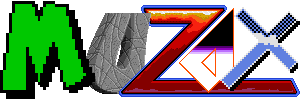
In the 2nd part of this Muzax episode dedicated to the games developed or released by Psygnosis, you will hear music from the games Ballistix, Blood money, Shadow of the Beast and Shadow of the beast 2 on the Amiga and Chrono quest II on the Atari ST.
Listen to this podcast : (comments in French)
Download this podcast in MP3 format by clicking on this link. (comments in French)
Content of broadcast:
Welcome to Muzax, the video games music broadcast.
Let’s continue our exploration of the music world from the games of the company “Psygnosis”.
The first 16-bit game developed by « Reflections Software » is « Ballistix » released in 1989.
Despite its meticulous production, this futuristic ball-game doesn’t manage to dethrone « Speedball » the famous game developed by « The Bitmap Brothers ».
« Dave Jones », founder of « DMA Design », developed « Blood Money » from his bedroom.
Being passionate about arcade games, this young Scottish man wanted to afford players the same thrills as in shoot’em up games available in amusement arcades.
The Amiga version of the game has two floppy disks. The first one is entirely devoted to its spectacularly high-resolution introduction.
The second floppy disk has the four levels of the game on it. Every level is a huge planet that the player has to explore in order to rid it of hordes of enemies.
The game is carefully produced; it stands out from the crowd due to its introduction and also its theme music written by « Ray Norrish ».
After Ballistix, Reflections Software produces one of its most beautiful games on the Amiga 500, « Shadow of the Beast ».
The reputation of every Psygnosis game is preceded by the company’s logo: the famous purple owl.
When he sees this, the player expects a high quality game.
« Shadow of the Beast » is no exception to the rule.
With 128 colours displayed simultaneously, 13 levels of parallax scrolling backdrops, 50 images per second and numerous sprites - some of them enormous, the Amiga version is a real technical achievement.
The game was a great success and was adapted to go on around ten platforms.
Once again, the music is written by « David Whittaker ». It is one of his biggest hits.
He is called upon to write exceptional music. He has achieved this by using high quality instrumental samples.
Despite being fairly ordinary in terms of manageability and in interest-value, the Amiga version of this legendary game has received several awards.
« Chrono quest II », also called « Explora II » in France, was released in 1990 on the Amiga, DOS and the Atari ST.
This second episode is full of even more meticulous graphics and digitalized voices.
Just one year after the release of the first episode, « Shadow of the beast 2 » was released on the Amiga.
This second game has taken on board the criticisms of the first. This follow-up version turns out to be more thought-provoking and challenging.
The drawback, however, is that on a technical level the game is less impressive.
The second part of this broadcast dedicated to Psygnosis is now over. Tune in soon for the next episode of Muzax!





